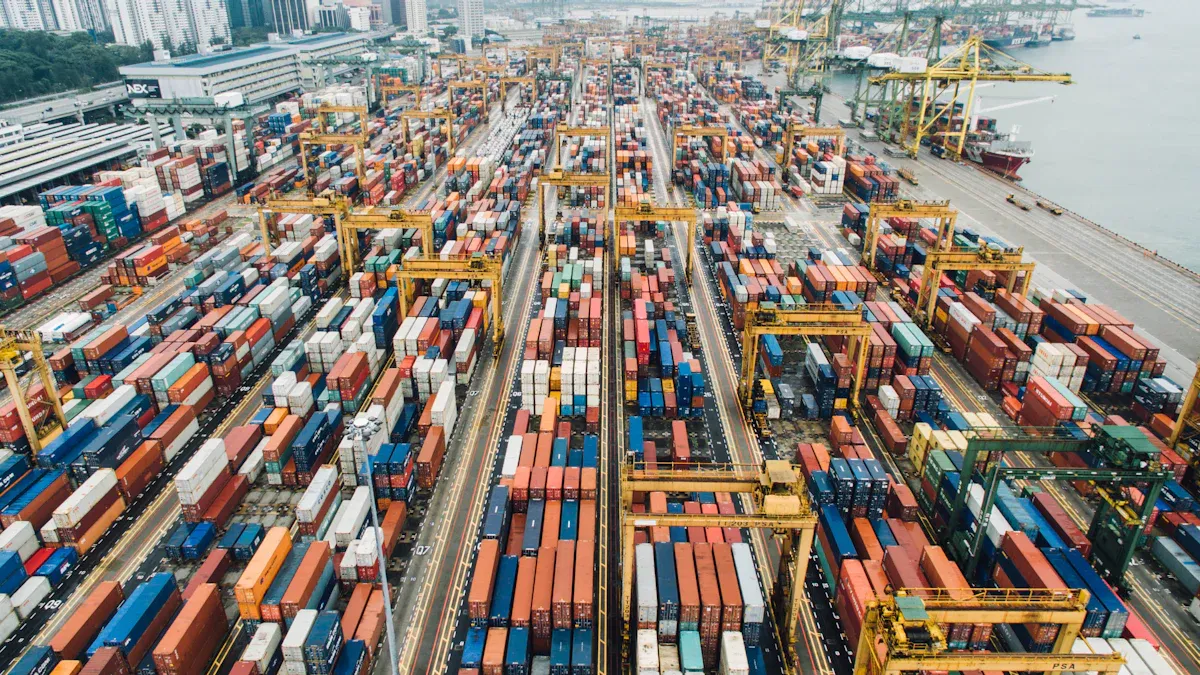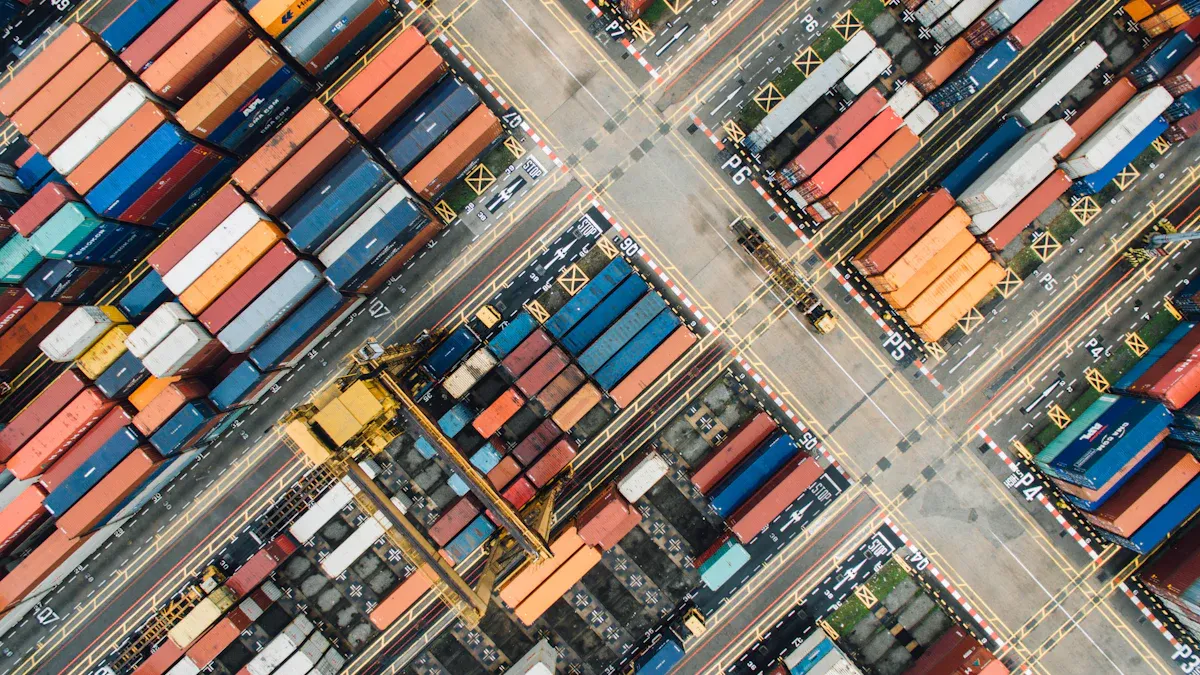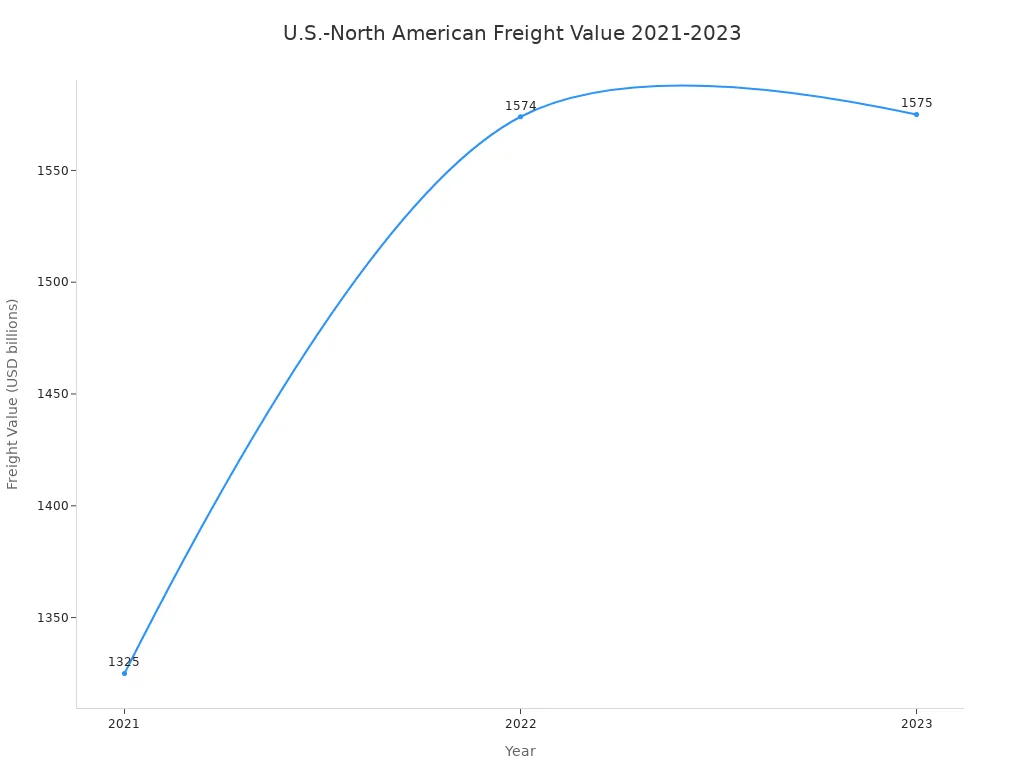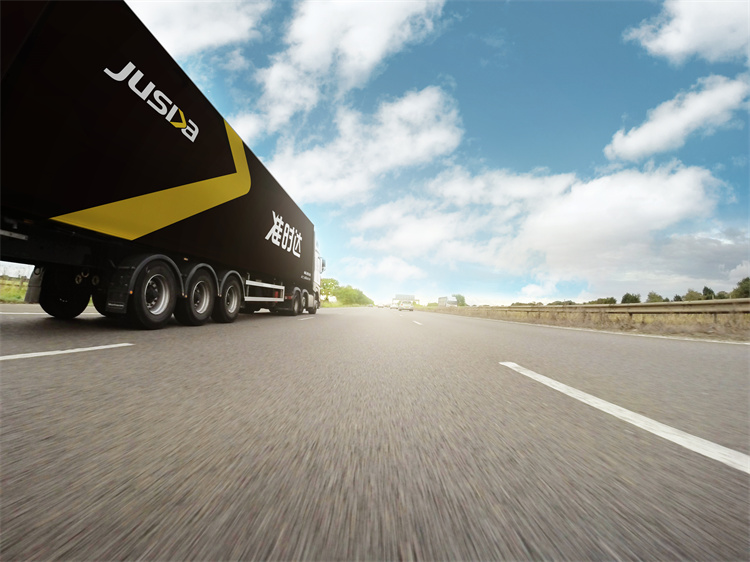Exploring the Role of Cross-border Logistics Companies

A cross-border logistics company moves goods to other countries. It helps businesses trade with people all over the world. These companies use new technology to make shipping quick and safe. This also makes shipping more reliable.
Year | Market Size (USD Trillion) |
|---|---|
2024 | 9.98 |
2034 (Projected) | 23.14 |
New digital tools help a cross-border logistics company watch shipments live. These tools also help stop delays.
Key Takeaways
Cross-border logistics companies help move goods between countries. They make sure goods are safe and arrive fast. They handle customs and all the needed paperwork. They pick the best way to ship, like by air, sea, road, or rail.
These companies use new technology like AI and real-time tracking. They also use digital tools to help with shipping. This helps stop delays and lowers costs. It also makes shipping more reliable and efficient.
Good logistics partners help businesses reach new markets. They help companies save money and follow hard rules. This makes global trade easier and faster.
Cross-border Logistics Company Overview

Core Functions
A cross-border logistics company helps move goods between countries. These companies do more than just deliver packages. They handle many jobs that make global shipping work.
They take care of customs rules and border checks. This means they make sure shipments follow the laws in both countries.
They get and check papers like bills of lading, certificates of origin, and customs forms. Shipping inside one country does not need as much paperwork.
They give choices for moving goods, like by sea, air, or ground. Each way has its own price and delivery time.
They deal with higher risks and costs. These include duties, taxes, currency changes, and longer shipping times.
Freight forwarders, a special kind of cross-border logistics company, focus on customs rules, cargo insurance, and use advanced tracking tools.
Domestic logistics companies mostly handle storage and filling orders. Cross-border companies must follow more rules and do harder jobs.
Note: Cross-border logistics companies use advanced technology to track shipments and help customers. This makes shipping safer and more reliable.
The table below shows how traditional and technology-driven cross-border logistics companies are different:
Aspect | Traditional Truckload Logistics | Technology-Driven Intermodal Logistics |
|---|---|---|
Customs Process | Standard customs checks at the border can cause delays | Advanced customs pre-clearance makes paperwork faster and reduces border delays |
Transit Time & Cost | Border traffic and waiting can make trips longer | Faster trips and lower costs because of smooth movement and pre-clearance |
Security | Needs extra steps like police escorts | Better security with constant movement, cameras, and safe transfers |
Handling of Sensitive Cargo | Risk of damage when moving goods between trucks | Can keep goods cold and safe with less spoilage |
Partnerships & Network | Only uses trucking routes | Works with railroads, transfer centers, and customs brokers for smooth service |
Efficiency & Reliability | More delays and higher extra costs | Better efficiency, reliability, and cost savings with technology and teamwork |
Importance in Global Trade
Cross-border logistics companies are important for connecting countries and helping trade. They let businesses sell to new places and send products to people everywhere.
These companies use direct mail service models for faster and more reliable deliveries.
They make order filling and warehouse work better, so shipping is quicker.
They use digital tools and machines, like robots and AI, to work faster and with fewer mistakes.
Data analytics helps them guess what people will buy, plan better routes, and keep track of goods.
Many companies use electric vehicles and green packaging to help the environment.
Working with partners and using new technology makes the global supply chain stronger and more connected.
Many groups watch what cross-border logistics companies do. The Bureau of Transportation Statistics says U.S.-North American freight was worth $1.57 trillion in 2023. Trucks moved over 60% of freight value with Canada and over 72% with Mexico. Surface transportation, like trucks and trains, made up more than 80% of freight by value.

Metric | 2021 | 2022 | 2023 | Change 2021-2022 | Change 2022-2023 |
|---|---|---|---|---|---|
Annual Value of U.S.-North American Freight Flows (USD billions) | 1,325 | 1,574 | 1,575 | +18.8% | 0.0% |
Freight Value U.S.-Canada (USD billions) | N/A | N/A | 774 | N/A | -2.4% |
Freight Value U.S.-Mexico (USD billions) | N/A | N/A | 799 | N/A | +2.5% |
Truck Freight Value (USD billions) | N/A | N/A | 996 | N/A | +5.1% |
Rail Freight Value (USD billions) | N/A | N/A | 209 | N/A | -0.5% |
A cross-border logistics company with strong freight skills helps global trade happen. Their work moves goods, connects businesses, and helps the world economy grow.
Cross-border Transportation Services & Operations

Modes of Transport
Cross-border transportation services use different ways to move goods. Air, sea, road, and rail each help in their own way. Air transport is fast and moves things like electronics and fresh food. It costs more than other ways. Sea transport moves most of the world’s cargo. Ships carry lots of goods far away. This is good for big or heavy items. Road and rail work for both short and long trips. Trucks and trains help deliver goods to the last stop. They also move goods between countries with land borders.
Logistics companies pick the best way by looking at what is being shipped. They also check how much needs to move, how far it goes, and how fast it must get there. For example:
Air transport is best for things that need to arrive fast or are worth a lot.
Road transport can go to places other ways cannot reach.
Rail transport is good for heavy or big things over land.
Sea transport is best for large shipments that are not in a hurry.
Intermodal solutions use two or more ways, like ships and trucks together.
Companies also think about cost, safety, and the environment when they choose. Good planning helps make sure shipping is fast and safe for businesses in electronics, cars, FMCG, and more.
Customs Compliance
Customs compliance is very important for cross-border transportation services. Every country has its own rules for bringing goods in or sending them out. Companies must follow these rules to stop delays, fines, or having goods held at the border.
Description | Typical Solutions | |
|---|---|---|
Regulatory Compliance and Documentation | Each country wants different papers and rules. | Stay updated, use customs brokers, and manage papers with special systems. |
Tariffs and Duties | Goods may have taxes or be put in the wrong group. | Use the right codes, ask experts, and check trade deals for lower costs. |
Customs Delays | Goods can get stuck at borders, which costs more money. | Send details early, build good ties with customs, and use tracking tools. |
Complex Tariff and Trade Agreements | Trade deals can be hard to follow and understand. | Use special software and keep up with changes in trade rules. |
Risk of Non-Compliance and Penalties | Not following rules can mean fines or lost goods. | Make compliance programs, check often, and train workers. |
Language and Cultural Barriers | People can get confused because of language or culture. | Hire people who speak many languages and teach teams about other cultures. |
Customs compliance has gotten harder in the last few years. This is true for expensive things like electronics and food. Countries now have more rules and paperwork. New laws, like the Uyghur Forced Labor Prevention Act in the U.S. and the EU Forced Labor Act, want proof that goods are made without forced labor. The EU Import Control System 2 asks for more import details. Because of these changes, companies need better technology and must work closely with customs officers to keep goods moving.
Tip: Companies that use digital customs tools and train their teams on new rules can stop many problems at the border.
JUSDA & JusTrade Solutions
JUSDA is a leader in cross-border transportation services. It has a global network and uses smart technology. The company’s JusLink supply chain platform connects every part of shipping. JusLink uses cloud computing, IoT, and big data to give updates in real time. This helps teams work together and makes shipping faster and clearer.
JUSDA helps many industries, like electronics, cars, FMCG, and medical equipment. The company offers air, land, sea, and rail choices. Clients can pick the best cross-border transportation service for their needs. JUSDA’s cloud warehousing and consolidation services help manage inventory and save money.
JusTrade is part of JUSDA and focuses on customs clearance. Its SAAS platform uses AI and big data to make customs paperwork easy and correct. JusTrade connects with clients’ systems, so information moves smoothly from buying to delivery. The platform works with many languages and currencies, so it is easy for clients around the world.
JUSDA and JusTrade help clients follow strict customs rules and new laws. Their technology checks papers, sorts goods, and tracks shipments live. This cuts down mistakes and makes customs clearance faster. By using AI tools, JUSDA and JusTrade help clients avoid delays and fines, even when rules change.
Note: JUSDA’s focus on new ideas, working well, and teamwork helps businesses do well in global trade. Their cross-border transportation services give clients what they need to move goods quickly and safely across borders.
Benefits & Challenges
Efficiency & Cost Savings
Cross-border logistics companies help businesses save time and money. They plan the best routes to make trips faster. Companies get better shipping prices because they ship a lot. Experts handle customs clearance, so there are fewer delays and fines. Many providers offer door-to-door service and manage papers. They also track cargo to make shipping easier. These steps help move goods smoothly and quickly. Extra services like warehousing and cargo insurance help lower costs.
Market Access
Logistics companies help businesses reach new markets. Small and medium-sized businesses use digital tools to find more customers. These tools can cut export costs by over 80%. They also make deals faster by almost a third. Businesses with good digital tools grow faster and sell in more places. Cross-border logistics providers help companies enter new markets. They offer reliable shipping, customs help, and last-mile delivery. This support lets businesses grow and build global brands.
Overcoming Obstacles
Companies face problems like customs delays, hard rules, and safety risks. Top logistics providers use technology to fix these issues. They use real-time tracking and digital customs clearance. They work with customs brokers and use safe payment systems. They also train workers to follow the rules. These steps help stop delays, keep shipments safe, and move goods on time.
JUSDA and JusTrade use AI and big data to make customs clearance automatic and give real-time updates. This helps clients avoid border delays and follow new rules.
Choosing a Cross-border Logistics Company
When picking a logistics partner, businesses should look for customs clearance skills. They should also want strong technology and a good network. Real-time tracking and flexible transport options are important. Proven results matter too. Companies like JUSDA are known for new ideas, speed, and teamwork. Special solutions for electronics, automotive, and FMCG help each client get the right support.

JUSDA Solutions
To provide you with professional solutions and quotations.
Cross-border logistics companies like JUSDA help global business grow. They use new technology and smart ideas to do this.
AI, IoT, and real-time tracking let companies deliver goods faster and safer.
Industry | Technology Used | Result |
|---|---|---|
Inventory management, AI | Fewer delays, better output | |
Healthcare | Real-time tracking, smart hubs | Faster delivery, saved lives |
JUSDA and JusTrade give strong and quick cross-border services for today’s world market.
See Also
Exploring New Approaches To Supplier Partnerships In Global E-commerce
Comprehensive Insights Into Leading Worldwide Logistics Providers
How Supply Chain Innovations Are Transforming Modern Logistics
Addressing Global Supply Chain Growth Issues In Today’s Market
Unlocking The Hidden Power Of Artificial Intelligence In Logistics
